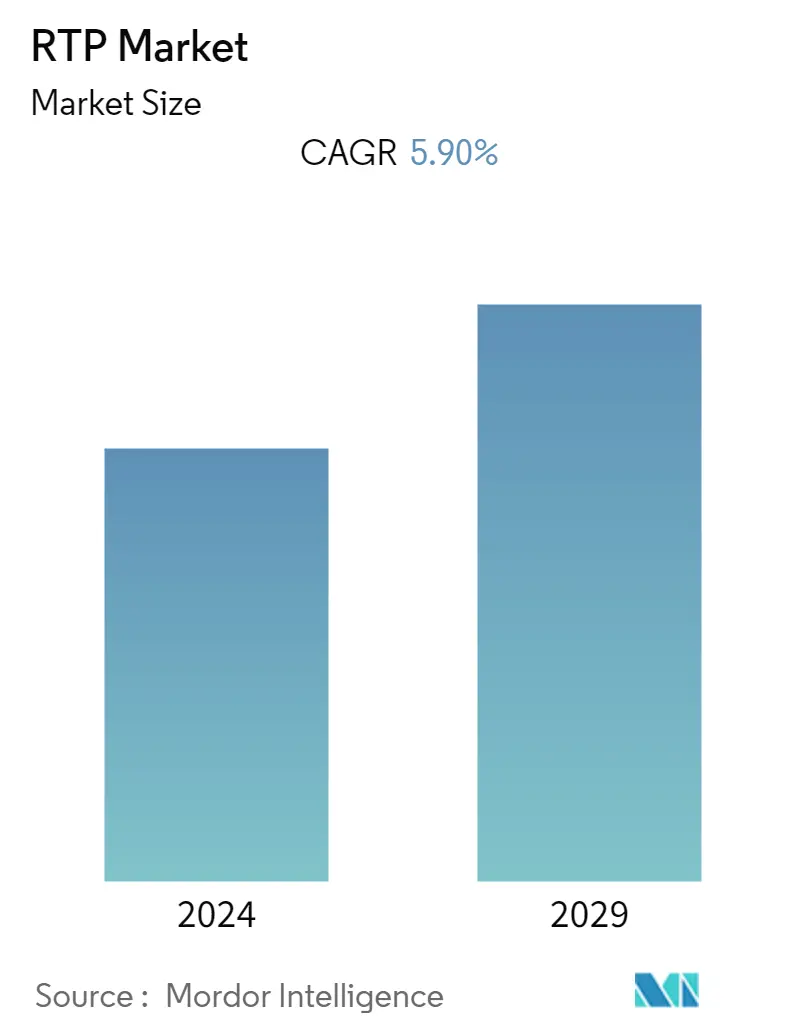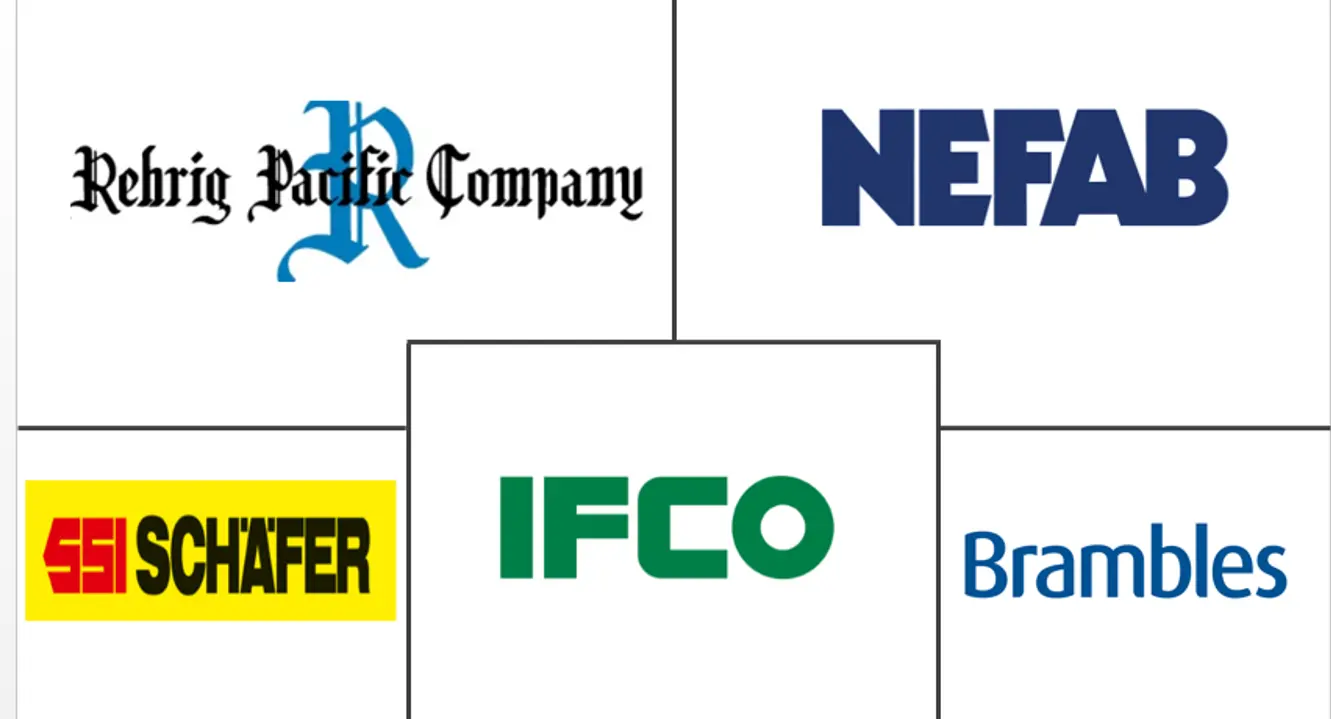Market Size of RTP Industry

| Study Period | 2019 - 2029 |
| Base Year For Estimation | 2023 |
| CAGR | 5.90 % |
| Fastest Growing Market | North America |
| Largest Market | Asia Pacific |
| Market Concentration | Medium |
Major Players
*Disclaimer: Major Players sorted in no particular order |
Returnable Transport Packaging Market Analysis
The Returnable Transport Packaging (RTP) market was valued at USD 7,827.5 million in 2020 and is expected to reach USD 11,040.06 million by 2026, at a CAGR of 5.9% over the forecast period (2021 - 2026). The increase in demand for the export and import of goods and e-commerce industry will drive the market in the forecast period.
- Returnable transport packaging (RTP) is a multi-trip packaging medium in which goods are transported more than once between the customers and vendors. The factors, like rising cost of packaging, damage to goods in transit, availability of packaging material, and the cost of disposing of the packaging material, have drawn the attention of the companies to sustainable packaging. Hence, the businesses are realizing the importance of having a sustainable and low-cost packaging system in place.
- RTP is increasingly gaining prominence worldwide, due to its positive effects on the environment. The packaging materials have contributed immensely to the depletion of natural resources.
- According to the global environment facility (GEF), the production of plastics, one of the most used packaging materials, increased by about twenty folds between 1964 and 2015, with an annual output of 322 million metric ton. The production is expected to be double by 2035 and quadruple by 2050.
- While plastics contribute to the economic growth, their current production and usage pattern, on a linear model of 'take, make, use, and dispose of', are the primary reasons for the depletion of natural resource, waste, environmental degradation, and climate change. These factors lead to adverse effects on human health. In addition, the usage of wood has exerted a tremendous pressure on forests.
- In addition, packaging has significantly contributed to global warming and the ozone layer depletion. It has placed excessive pressure on the environment, owing to the unceasing disposal of waste. Packaging also contributes to landfill space and serves as a source of toxic materials, with health implications and the risk of groundwater contamination.
- To deal with these negative consequences of packaging, RTP enables the firms to reduce their operational costs and reduce the environmental impact, while conforming with the government's regulations for sustainable supply chains.
Returnable Transport Packaging Industry Segmentation
Returnable transport packaging (RTP) is a kind of packaging where it can be used for more than one trips. These goods can be transported in the city, nationally or could be internationally between vendors and customers. The transport is done in pallets, drums, containers, etc. Transportation is mainly done in the automotive sector and in the consumer goods industry.
| Material | |
| Plastic | |
| Metal | |
| Wood |
| Product | |
| Containers | |
| Drums & Barrels | |
| Pallets | |
| Crates, Totes, Trays & Bins | |
| Intermediate Bulk Containers (IBC's) | |
| Other Product Types |
| Application | |
| Automotive | |
| Food and Beverages | |
| Consumer Goods | |
| Industrial | |
| Others |
| Geography | |
| North America | |
| Europe | |
| Asia Pacific | |
| Latin America | |
| Middle East and Africa |
RTP Market Size Summary
The Returnable Transport Packaging (RTP) market is experiencing significant growth, driven by the increasing demand for sustainable and cost-effective packaging solutions. RTP, which involves multi-trip packaging systems, is gaining traction due to its ability to reduce packaging costs, minimize damage during transit, and decrease environmental impact. The shift towards sustainable packaging is largely influenced by the rising costs and environmental concerns associated with traditional packaging materials, such as plastics and wood. As companies seek to align with government regulations and reduce their carbon footprint, RTP offers a viable solution that supports sustainable supply chains. The market is further bolstered by the growing e-commerce sector and the need for efficient logistics in global trade.
In North America, the RTP market is particularly robust, supported by a strong manufacturing base and the presence of major industries such as pharmaceuticals, chemicals, and automotive. The region's focus on technological advancements in packaging solutions enhances its competitive edge. Drums, a crucial component of RTP, are widely used across various sectors for storing and transporting liquids, with plastic and steel drums being the most common due to their durability and reusability. However, concerns over plastic waste have led to a shift towards alternative materials like steel, which offers benefits such as recyclability and lower lifecycle costs. The market is characterized by moderate competition, with key players focusing on improving the quality of transport packaging rather than engaging in aggressive competition.
RTP Market Size - Table of Contents
-
1. MARKET DYNAMICS
-
1.1 Market Overview
-
1.2 Market Drivers
-
1.2.1 Demand for RTP from F&B, and Textile Industries
-
1.2.2 Stringent Government Regulations by the Government
-
-
1.3 Market Restraints
-
1.3.1 High Initial Costs to Setup and Buying all Kinds of Matericals
-
-
1.4 Industry Value Chain Analysis
-
1.5 Industry Attractiveness - Porter's Five Force Analysis
-
1.5.1 Threat of New Entrants
-
1.5.2 Bargaining Power of Buyers/Consumers
-
1.5.3 Bargaining Power of Suppliers
-
1.5.4 Threat of Substitute Products
-
1.5.5 Intensity of Competitive Rivalry
-
-
1.6 Assessment of Impact of Covid-19 on the Market
-
-
2. MARKET SEGMENTATION
-
2.1 Material
-
2.1.1 Plastic
-
2.1.2 Metal
-
2.1.3 Wood
-
-
2.2 Product
-
2.2.1 Containers
-
2.2.2 Drums & Barrels
-
2.2.3 Pallets
-
2.2.4 Crates, Totes, Trays & Bins
-
2.2.5 Intermediate Bulk Containers (IBC's)
-
2.2.6 Other Product Types
-
-
2.3 Application
-
2.3.1 Automotive
-
2.3.2 Food and Beverages
-
2.3.3 Consumer Goods
-
2.3.4 Industrial
-
2.3.5 Others
-
-
2.4 Geography
-
2.4.1 North America
-
2.4.2 Europe
-
2.4.3 Asia Pacific
-
2.4.4 Latin America
-
2.4.5 Middle East and Africa
-
-
RTP Market Size FAQs
What is the current RTP Market size?
The RTP Market is projected to register a CAGR of 5.90% during the forecast period (2024-2029)
Who are the key players in RTP Market?
IFCO Systems, Nefab AB., SSI Schaefer Limited, Rehrig Pacific Company and brambles limited (CHEP) are the major companies operating in the RTP Market.

